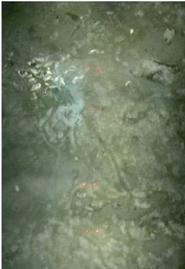
The chance discovery of a vast ecosystem beneath the collapsed Larsen Ice Shelf will allow scientists to explore the uncharted life below Antarctica's floating ice shelves and further probe the origins of life in extreme environments. Researchers discovered the sunless habitat after reviewing an underwater video study examining a deep glacial trough in the northwestern Weddell Sea following the sudden Larsen B shelf collapse in 2002.
"This is definitely the biggest thing I've ever been involved with in the Antarctic," said Eugene Domack, a geosciences professor and lead author of the report detailing the ecosystem. The article will be published in the July 19 issue of Eos, the weekly newspaper of the American Geophysical Union. "Seeing these organisms on the ocean bottom--it's like lifting the carpet off the floor and finding a layer that you never knew was there."
Domack suggests the strong possibility that new species of marine life may be uncovered in continuing analyses of the area as ecosystem experts sample the site. The international expedition was there on a U.S. Antarctic Program cruise to study the sediment record in the area vacated by the former ice shelf. The crew recorded a video of the seafloor at the end of its mission and only later discovered a thriving clam community, mud volcanoes and a thin layer of bacterial mats.
The discovery was made during a 2005 trip to Antarctica led by Domack to continue his ongoing investigation of the causes for the collapse of a massive ice sheet known as Larsen B. He was accompanied by a group of Hamilton undergraduate students along with students and professors from five other institutions including Colgate University. Domack has taken more than 100 undergraduates to Antarctica since 1987. These expeditions are among the very few that include undergraduate student researchers.
This was the second year of a three-year multi-institutional, international effort that combines a variety of disciplines and integrates research with educational opportunities. In 2004, Domack was awarded $851,941 from the National Science Foundation Office of Polar Programs in support of these expeditions.
This discovery could provide evidence for researchers to better understand the dynamics within the inhospitable sub-ice setting, which covers more than 1.5 million square kilometers [nearly 580,000 square miles] of seafloor, or an area of the same magnitude to the Amazon basin in Brazil or the Sahara Desert. The ecosystem, known as a "cold-seep" (or cold-vent) community, is fed by chemical energy from within the Earth, unlike ecosystems that are driven by photosynthesis or hot emissions from the planet's crust. Domack and his coauthors propose that methane from deep underwater vents likely provide the energy source capable of sustaining the chemical life at the observed 850-meter [approximately 2800-foot] depth.
Such extreme cold-vent regions have previously been found near Monterey, California, where the phenomenon was discovered in 1984, in the Gulf of Mexico, and deep within the Sea of Japan. The recent report, however, presents the first finding of the type in the Antarctic, where the near-freezing water temperatures and almost completely uncharted territory will likely provide a baseline for researchers to probe portions of the ocean floor that have been undisturbed for nearly 10,000 years. The researchers speculate, for example, that the ice shelves themselves may have played a critical role in allowing the chemical habitat to thrive on the seafloor when it otherwise might not have established itself.
Domack noted, however, that the collapse of the Larsen B Shelf has opened the pristine chemical-based ecosystem to disturbances and debris that have already begun to bury the delicate mats and mollusks established within the underwater environment. He added that there may be a sense of urgency to investigate the unusual seafloor ecology below the Larsen shelf because of the likelihood of increased sediment deposition.
In addition, he suggests that the newfound system may provide incentive to launch studies to other remote undersea environments in the Poles and in other glacial settings such as Lake Vostok, also in the Antarctic, to further explore the little-understood connection where ice sheets, the seafloor, and circulating water meet. The researchers indicate that the knowledge gained from any subsequent studies could enhance the examination of subterranean water on Earth or the hypothesized ocean beneath the surface on the Jovian moon Europa.
The research was supported by National Science Foundation grants to Hamilton College, Colgate University, and Southern Illinois University.
Posted July 18, 2005
